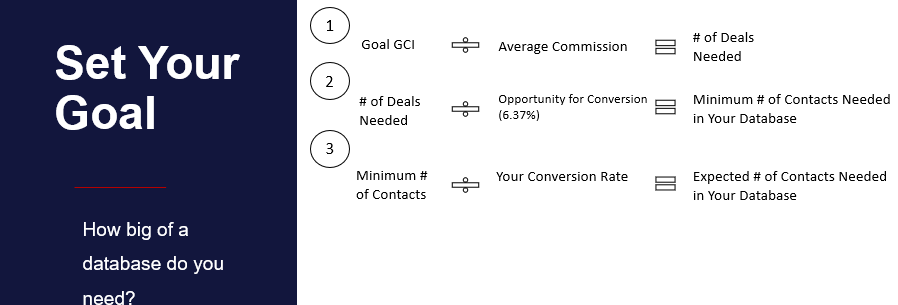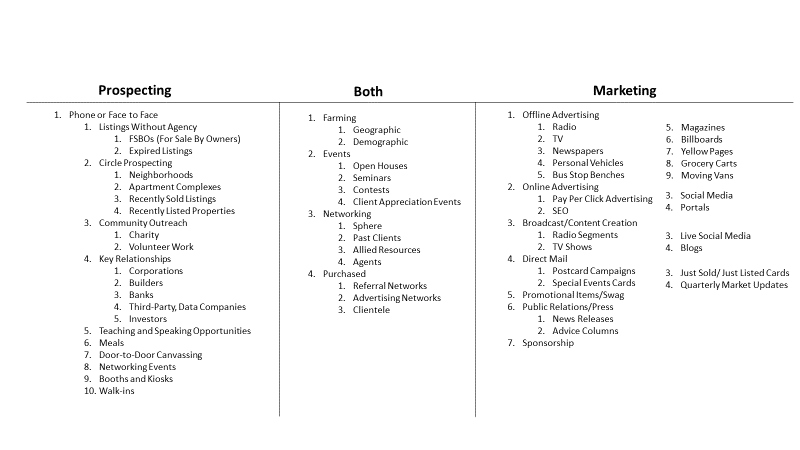This article is the second in our “Back to Business Basics” series – aimed at helping you achieve greater success by using models outlined in Gary Keller’s The Millionaire Real Estate Agent. The MREA shows you how to achieve your goals and where to focus your time to achieve the greatest impact. Successful agents have left clues: a trail of their actions which led to their desired results. The MREA is a compilation of those clues.
Related Read: The Economic Model: Your Shortcut to More Real Estate Sales
Since its original publication 17 years ago, the MREA has sold 1.3 million copies – withstanding market conditions and the test of time to help both new agents and seasoned pros alike.
Don’t recreate the wheel. Let the MREA be your guide.
“No leads means no sales.” – Gary Keller
Outlined in the MREA, lead generation is one of the Three Ls of a successful real estate business; leads, listings, and leverage; or the 20% that will yield you 80% of your results. Yet many agents struggle with maintaining a successful lead generation strategy or start veering away from it. Keller explains how lead generation must continue to be your most important focus, no matter how successful you become.
“The number of qualified leads you have will either grow your business, keep you in business, or put you out of business,” he writes. “Nothing else about your business will have as big an impact on it as the number of leads you have.”
In order to identify how many people you will need in your database in order to achieve your goals, consider the following equations:
1. Goal GCI ÷ Average Commission = # of Deals Needed
2. # of Deals Needed ÷ Opportunity for Conversion (6.37%) = Minimum # of Contacts Needed in Your Database
3. Minimum # of Contacts ÷ Your Conversion Rate = Expected # of Contacts Needed in Your Database

So, how can agents immediately strengthen their lead generation?
First, by focusing on prospecting and marketing over lead receiving.
- Prospecting and Marketing: Prospecting is about finding people, while marketing is about attracting them, so they find you.
- Lead Receiving: When agents rely on passive lead generation, casual referrals, and luck to build their business. This can be dangerous, especially when the market shifts.

Prospect and Market for Lifelong Relationships
As highlighted in the MREA pages 142-143, the goal of your lead generation program should be to build a strong database, fueled by building long-term relationships, which will eventually become future business.
Your database of leads will contain several groups of people that fall into two broad categories:
- Leads – People who have shown some sort of interest in the services you offer, but who haven’t yet engaged in a two-way conversation with your business.
- Contacts – Leads that you have held a two-way conversation with and have established a value-based relationship with.
To get started assembling your lead gen program…
Create a list of all and a systematic plan for reaching out and establishing relationships with your leads over the next 12 months. Employing a variety of techniques (direct mail, email, text message, phone calls) will generate more sources for you – and help you convert faster.
For instance, if someone registered on your website and looked at a few homes in a specific neighborhood, it would be easy to assume that one of the touches in your 19 to Connect should be providing them a market report on that neighborhood. Or, if you purchased a list of expired listings and loaded the list into your leads, then you probably already know that they’ve tried to sell their home and failed – using a real estate agent. Tailoring the messaging of your 19 to Connect to inform them of their options and to assuage their fears would be a great example of providing relevant value to them.

Once you’ve converted your leads into contacts, you can create groups – collections of people that share a characteristic. This unifying trait can be as diverse as the people themselves. Some agents create groups around characteristics such as the type of neighborhood they’re looking to move to. Some are grouped by their age or family size. And others are formed by what sports and teams they’re fans of. There’s no limit to the number of groups in your database. And, the more detailed they are, the more effective your communication will become.
Don’t forget that a past client can be a source of future business: always think long term when it comes to client relationships. When 72% of buyers and sellers say they would definitely work with their agent, it’s paramount you focus on them as a source of repeat, future business.
Feed Your Database
Once your database is intact with names and contact details of the individuals you’d like to grow in relationship with, continue to feed it. A database is a living thing that needs to be fed with new contacts, so never put it on a diet.
One of the most effective ways to grow your database is through referrals.
“The size of your real estate business will be in direct proportion to the size and quality of your database.” – Gary Keller
Always ask for referrals – every time you have a conversation or send a communication. At a closing, for example. Never automatically assume that someone you meet doesn’t know anyone who wants to buy or sell a home.
And, if you reach out and the referral isn’t interested in buying or selling?
Keep these leads in your database and create a plan for regular touches. Life happens; things change. Don’t drop the ball and let another agent pick them up when they are ready.
Systematically Market to Your Database
Since the MREA’s release in 2004, Keller Williams has revolutionized the lead gen process by streamlining communication and marketing through technology so you can focus on cultivating deeper relationships with your clients.
Within Command – Keller Williams’ end-to-end operational system – SmartPlans is a workflow-management tool that helps agents automate listing checklists, marketing touchpoints, drip campaigns, and more, so they can take the guesswork out of communications with clients and leads. The communication is meaningful and happens when it matters.
SmartPlans can be assigned to any contact once it is uploaded and grouped through tagging in Command. The best part? The system updates in real time and catalogs every touch for an in-depth history of when every contact is made.
Protect Your Lead Generation Time
You will find that day-to-day administrative tasks, personnel issues, and other responsibilities can eat up a lot of your workday, particularly as your team grows. That said, don’t let these veer you off track: delegate those duties and commit a generous time block to lead generation, guarding it against intrusion. Use this time to prospect, follow up with existing leads, and assign leads to SmartPlans. Nothing short of an actual emergency should pull you away from lead generation. And, no matter how good business is, never take your foot off the gas.
“While time really isn’t money, it is convertible to money. Ultimately, lead generation is the most dollar-productive activity you can do for your real estate business.” – Gary Keller